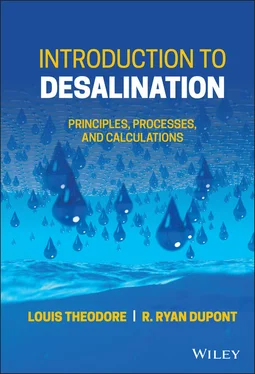Tributary – A stream or river that flows into a larger stream or main stem (or parent) river or a lake.
Trough – A structure employed to hold or transport fluids.
Tsunami – A sea wave caused by an underwater seismic disturbance such as sudden faulting, a landslide, or volcanic activity.
Turbid water – Water that is cloudy due to fine particles in suspension.
Turbidity – A measure of the fine particles suspended in a fluid; measured as the proportion of light passed through a sample that is refracted by suspended particles in a water column.
Ultrafiltration – The separation of a solute with a specific molecular size and shape from a solution by applying pressure to force the solvent to flow through a membrane.
Underground sources of drinking water – The aquifers that are currently being employed as a source of drinking water, and those that are capable of supplying a public water system.
Unconfined aquifer – An aquifer whose upper surface is free of a confining layer and thus is able to fluctuate under atmospheric pressure.
Upstream – The regions of a river system located in the direction opposite to the flow of a stream from a given position; a section of a river system that is hydraulically higher, if gravity transports the water away from the given location.
Uptake – The act of taking up, drawing up, or absorbing.
Urban runoff – The storm water from city streets and adjacent domestic or commercial properties.
Utility – Public water service provider.
Vapor pressure – The pressure exerted by a vapor in equilibrium with a liquid at a given temperature.
Virgin material – A raw, unused material.
Wake – The visible trail of turbulence left behind a moving stream.
Wash solvent – A liquid added to a liquid–liquid extraction to wash or enrich the purity of the solute used in the extraction process.
Wash water – The water employed to wash equipment.
Wastewater – The water used to carry liquid waste material, consisting of dissolved and suspended solids, organics, and nutrients from homes, businesses, institutions, and industries to wastewater treatment plants for contaminant removal prior to release to surface water.
Wastewater operations and maintenance – The actions taken after construction of wastewater treatment facilities to assure that the facilities will be properly operated and maintained.
Wastewater treatment – A series of processes in which wastewater is treated in order to remove or alter its objectional constituents to a degree that renders it less harmful or dangerous.
Wastewater treatment plant – A series of unit operations including screening, sedimentation, digestion, stabilization, dewatering, disinfection, and other processes for removing pollutants from wastewater before it discharges into the environment.
Wastewater treatment unit – A device that is part of a wastewater treatment facility which is subject to regulation.
Water – A colorless, odorless, tasteless liquid composed of the elements hydrogen and oxygen.
Water audit – Program involving sending trained water auditors to participating family homes, free of charge, to identify water conservation opportunities such as repairing leaks and installing low-flow plumbing and to recommend changes in water use practices to reduce home water use.
Water conditioning – The treatments, excluding disinfection, that are intended to produce a water which is free of taste, odor, and undesirable contaminants.
Water conservation – Activities designed to reduce the demand for water, improve efficiency of use, and reduce losses and waste of water in a potable water system.
Water consumption – The quantity of water supplied in a municipality or district for a variety of uses during a given period.
Water main – The water pipe, located in the street, from which domestic water supply is delivered to specific premises.
Water pollution – The contamination of fresh or saltwater with materials that are toxic, noxious, or otherwise harmful to fish, man, or other animals.
Water purification – Any process in which water is treated in such a way as to remove or reduce undesirable impurities.
Water quality – The chemical, physical, or biological characteristics of water with respect to its suitability for a particular purpose.
Water quality criteria – The specific levels of water quality that, if reached, are expected to render a body of water suitable for its designated beneficial use.
Water quality standards – The state-adopted, EPA-approved, allowable numeric ambient water quality concentrations for surface water bodies defined for each beneficial use.
Water recycling – Reuse of water for the same application for which it was originally used.
Water reuse – Using treated wastewater (reclaimed water) for some beneficial purpose rather than discharging it to surface water; the deliberate use of reclaimed wastewater must be in compliance with applicable rules for a beneficial purpose (landscape irrigation, agricultural irrigation, aesthetic uses, ground water recharge, industrial uses, or fire protection).
Water rights – The rights acquired under the law to use surface or groundwater for a specified purpose, in a given manner, and usually within the limits of a given period.
Water softening – A treatment process designed to completely or partially remove hardness-producing ions, Ca2+ or Mg2+, from a potable water.
Water solubility – A measure of the maximum concentration of a chemical compound that can result when it is dissolved in water.
Water supplier – A person who owns or operates a water supply system; they can be public or private.
Water supply system – The collection, treatment, storage, and distribution of potable water from source to consumer.
Water surcharge – Imposition of an increased cost due to excessive water use.
Water table – The upper level of the groundwater below which the ground is saturated with water.
Water treatment – The purification of water to make it suitable for drinking or other beneficial uses.
Waterlog – Occurs when water is added to land faster than it can drain.
Watershed – The area surrounding a stream that supplies it with runoff.
Waterway – Any body of water, other than the open sea, that is or can be employed by boats as a means of travel.
Well – A bored, drilled, or driven shaft, or a dug hole, whose depth is greater than the largest surface dimension and whose purpose is to reach underground water supplies, or to store or bury fluids below ground.
Wetland – An area covered or saturated permanently, occasionally, or periodically by fresh or salt water.
WHO – World Health Organization of the United Nations, based in Geneva ( www.who.int).
1 Theodore, L., Reynolds, J., and Morris, K. (1997). Concise Dictionary of Environmental Terms. Amsterdam, The Netherlands: Gordon and Breach Science Publishers.
3 Engineering Principles
3.1 Introduction
This chapter introduces the reader to the general subject of engineering principles. Seven topics are addressed in the chapter that include: the metric system, SI multiples and prefixes, conversion constants, dimensional analysis, flow diagrams, significant figures and approximate numbers, and generic problem-solving techniques. A series of illustrative examples are provided to highlight concepts presented throughout the chapter.
The need for a single worldwide coordinated measurement system was recognized over 300 years ago. Gabriel Mouton, Vicar of St. Paul in Lyons, proposed a comprehensive decimal measurement system in 1670 based on the length of one minute of arc of a great circle of the Earth. In 1671 Jean Picard, a French astronomer, proposed the length of a pendulum beating seconds as the unit of length. (Such a pendulum would have been easily reproducible, thus facilitating the widespread distribution of uniform standards). Other proposals were made, but over a century elapsed before any action was taken.
Читать дальше












